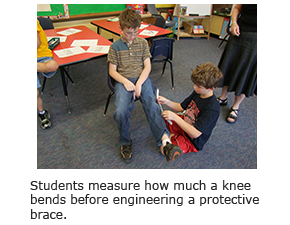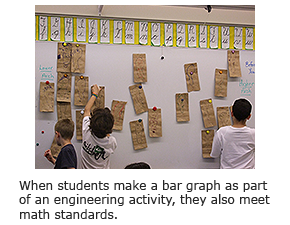Last summer EiE’s curriculum team had quite a few projects in the pipeline. Just the same, they added a new goal: Making it easy for educators to understand how the 20 Engineering is Elementary curriculum units address the Common Core State Standards (CCSS).
“We didn’t have specific funding to accomplish the project,” says Melissa Higgins, EiE’s director of curriculum development. “But we knew it was a resource teachers needed. With so many states adopting the Common Core, teachers have to make the case that they’re meeting these standards. Meanwhile there’s so much that has to fit into the school day, we want to make it simple for teachers to see all of the learning goals they can address with one EiE activity.”
Engineering Activities Use Math and ELA Skills
The EiE curriculum was completed before the Common Core standards were released. Just the same, relevant skill-based math practices are part of the activities in almost every EiE unit: practices like making sense of problems, persevering to solve them, and reasoning both abstractly and quantitatively. This short video (below) gives an example from the EiE “Designing Parachutes” unit.
When it comes to English Language Arts, the storybooks and the writing activities embedded in the EiE units provide many opportunities for students to practice the literacy and writing skills required by the CCSS. “We were confident before we started that we would find many common core connections in EiE,” Higgins says.
How Do You Connect EiE to Common Core?
With all this in mind, the team of energetic curriculum developers rolled up their sleeves and began the painstaking process: working through the standards grade by grade, from 1 up to grade 5, finding connections between the activities in each of the four lessons in each of the 20 EiE units and CCSS.
Team members worked in pairs, one serving as the primary mapper, the other cross-checking. To give an example of the process, Higgins points to the EiE biomedical engineering unit on designing knee braces.

“Lesson 2 includes an activity where each student measures the arch of his or her foot; then the class aggregates the data on a big bar graph on the classroom wall, to see where the numbers cluster,” Higgins notes. “The Common Core math standards in the ‘measurement and data‘ domain for grade 2 specify (among other goals) that students should both represent and interpret data, so the activity meets that goal. We also have students write a letter to the fictional ’Fast Feet Shoe Company‘ introduced in the lesson. This activity supports some of the CCSS writing standards, such as participating in a shared research and writing project.
More Ways to Connect Engineering and CCSS
Long before they started mapping EiE to CCSS, EiE’s curriculum developers had already put together other useful tools for connecting engineering activities to standards, including extension lessons, while EiE’s professional development team created a new professional workshop, “Linking the E & M in STEM,” for teachers who are new to both EiE and CCSS. Fourth-grade teacher Caitlin Nunez of Plainville, MA, attended this past July.
“The workshop provided a nice blend of hands-on experience with the EiE curriculum kits and ideas for incorporating more CCSS math into the engineering tasks,” Nunez says. “There are so many links between math and engineering in the elementary classroom; I feel ready to take on the challenge of implementing cross-curricular math tasks based on the EiE unit I will be teaching.”
Get the EiE CCSS Tools
You can find the concise CCSS mapping summaries on our website--along with similar resources for state standards and the Next Generation Science Standards. “Write and tell us what you think,” Higgins says. “Did it save you time? Was it useful? We’d love to hear from teachers.”
Common Core Math: http://www.eie.org/eie-curriculum/math-common-core-standards-mapping
Common Core ELA: http://www.eie.org/eie-curriculum/ela-common-core-standards-mapping
Engineering is Elementary is a project of the National Center for Technological Literacy at the Museum of Science, Boston.








